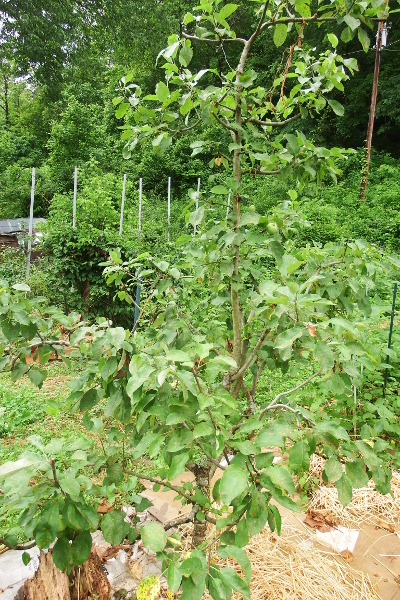
Why summer train and prune apple trees?
 "Anna, you two seem to put so
much effort into your highly managed orchard plot. What are the
advantages of that effort vs just letting apple trees grow without
interference?" --- doc
"Anna, you two seem to put so
much effort into your highly managed orchard plot. What are the
advantages of that effort vs just letting apple trees grow without
interference?" --- doc
The advantages are more
fruit faster, or at least so the theory goes. I'm too early in the
experimentation process to say for sure whether it's working, but early
results seem positive.
For example, take a look
at the two trees in this post. Both are early transparent apples (aka
yellow transparents). Both are on dwarfing rootstock.
The one illustrated in the top picture was planted in February 2009 and
pruned using standard, minimal winter-pruning techniques. It seemed so
averse to fruiting that I considered ripping it out a couple of years
ago, but instead changed it over to a
crazy looping method that I slowly morphed into my usual high-density
training method. And this year, we finally have fruit on the
limbs...although only seven apples over the whole rather large tree.
 In contrast, the second tree
(same variety, same rootstock) was planted in late 2012 (so four growth
seasons later). It's currently loaded with apples (36) and would have
fruited last year too if we hadn't experienced a deep freeze.
In contrast, the second tree
(same variety, same rootstock) was planted in late 2012 (so four growth
seasons later). It's currently loaded with apples (36) and would have
fruited last year too if we hadn't experienced a deep freeze.
I know many people enjoy
the low-work approach and point to mature, standard apple trees that
bear well with minimal pruning and training. The trouble is, those
trees are humongous (one would take up a quarter of my garden) and they
might not fruit for over a decade. A little extra work --- about 2
hours per month for all of our fruit trees combined --- really does
seem worth a greater variety and volume of apples now rather than
waiting until I'm completely gray to taste the first bite.
Want more in-depth information? Browse through our books.
Or explore more posts by date or by subject.
About us: Anna Hess and Mark Hamilton spent over a decade living self-sufficiently in the mountains of Virginia before moving north to start over from scratch in the foothills of Ohio. They've experimented with permaculture, no-till gardening, trailersteading, home-based microbusinesses and much more, writing about their adventures in both blogs and books.
Want to be notified when new comments are posted on this page? Click on the RSS button after you add a comment to subscribe to the comment feed, or simply check the box beside "email replies to me" while writing your comment.

Thanks Anna! Your posts and blog are an inspiration for a novice and part time garden enthusiast like myself.
I certainly plan on doing an update with plenty of pictures on the progress of the micro-orchard project at least once a year, possibly more. This year is mostly going well so far though as we all know the continuing challenges of gardending and growing fruit are enough to keep anyone humble.
Didn't have much dormant pruning to do, but I did snip a couple pieces to do scion trading with another member at GrowingFruit.org which was cool.
I began the execution of my multi-grafting plans on these trees, adding 6 new varieties. Mostly cleft grafts with a few W&Ts thrown in. 12 out of 13 grafts are doing great, though aphid pressure is heavy this year and the new growth of grafts seems to be especially delicious for aphids.
dug up and replaced the one tree I killed last year with an ill-advised neem oil treatment as a prophylactic measure against borers
pinching new growth every couple days as the main summer activity, while periodically strapping the new growth I let run to the right spots on the training lattice periodically
All my apples on interstem rootstock wanted to fruit heavily this year (3rd leaf) but I thinned them down to a handful per tree since I want the trees to grow out more before spending too much energy on fruit. All the same, I hope to enjoy a few Rox. Russet, Gold Rush, and Opalescent in fall.
I stripped all fruitlets from my interstem Ashmead's Kernel since it is weakened by last year's raw neem incident and I'm hoping it will rally. Tried to help it along by attempting an inarch graft with a piece of G.30 rootstock planted right next to the trunk.